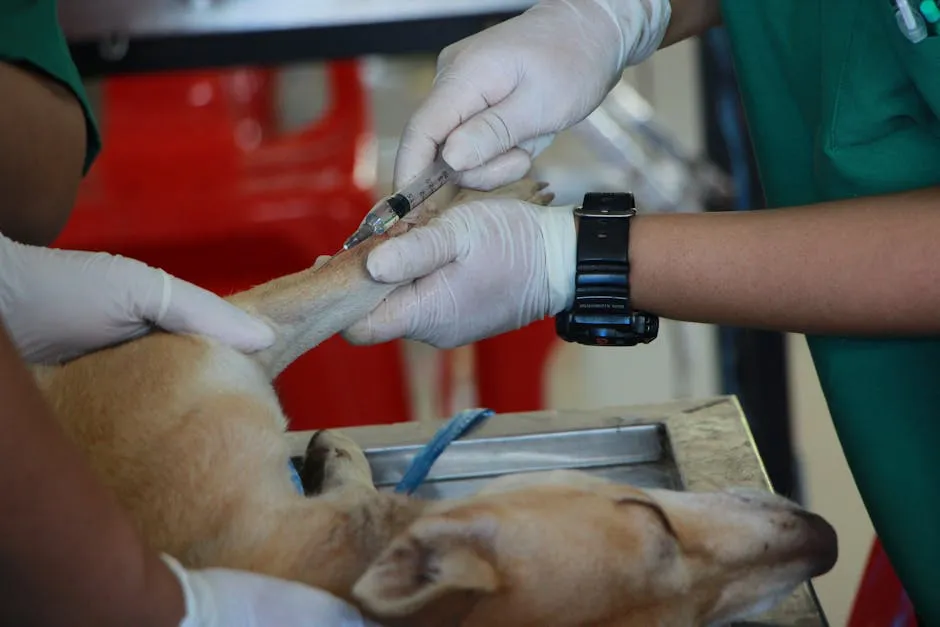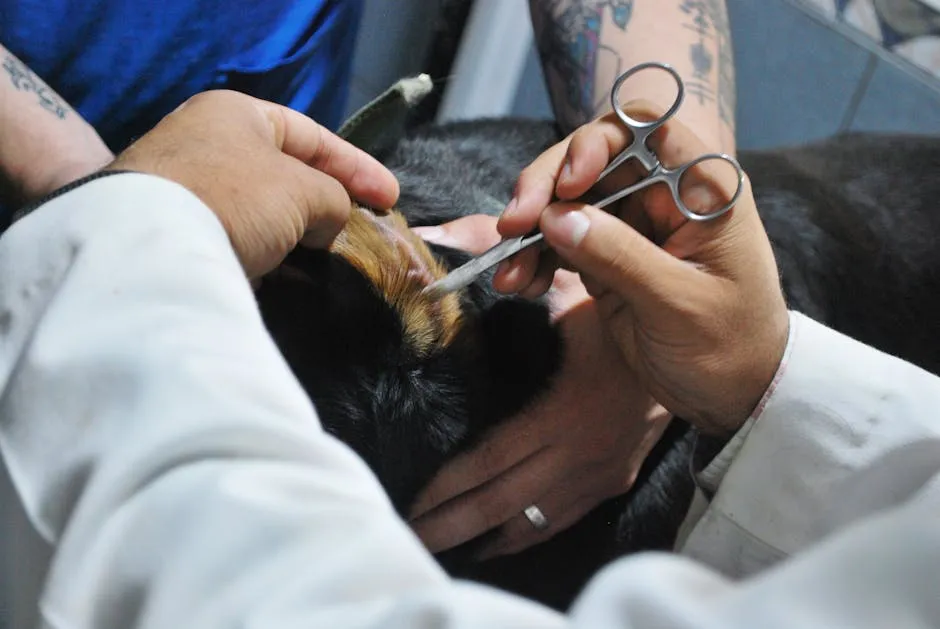Introduction
Ear mites are a common issue for many dogs. These tiny parasites cause intense discomfort and irritation in your furry friend. Early detection and treatment are crucial to prevent complications, such as secondary infections. Knowing the signs can help you act quickly, ensuring your dog’s ears remain healthy.
To keep your dog comfortable and free from pesky parasites, consider using Vet’s Best Ear Relief Wash for Dogs. This gentle solution helps soothe irritation, making your dog’s ears feel better while you tackle the underlying issue.
Summary and Overview
Ear mites, or Otodectes cynotis, are microscopic parasites that live in your dog’s ear canal. They primarily feed on ear wax and oils, leading to irritation. Symptoms include excessive scratching, head shaking, and dark, waxy discharge resembling coffee grounds. Transmission occurs through direct contact with infected animals or shared bedding. Puppies and outdoor dogs are at higher risk, as they often interact with other pets.

Veterinary diagnosis is essential for effective treatment. Your vet will confirm the presence of mites and rule out other conditions. Treatment typically includes topical medications and thorough ear cleaning. Prevention strategies involve regular ear inspections, maintaining a clean environment, and keeping your dog away from infected animals.
Understanding how to manage your dog’s health is crucial. For more information, check out Understanding and managing canine arthritis symptoms.
Understanding Ear Mites in Dogs
What Are Ear Mites?
Ear mites are tiny parasites, usually measuring 1-2 millimeters. They thrive in the ear canal and on the skin’s surface. These mites reproduce quickly, with a life cycle that includes egg, larval, and adult stages. Adult mites live for about two months, continuously feeding and breeding. Differentiating ear mites from other issues, such as yeast infections or allergies, is crucial, as symptoms can overlap.
How Dogs Get Ear Mites
Dogs typically contract ear mites through close contact with infected animals, such as other dogs or cats. Shared bedding and grooming can also facilitate transmission. Puppies are particularly susceptible due to their underdeveloped immune systems. Dogs that spend time outdoors or in multi-pet households face a higher risk of infestation. Regular monitoring and preventive measures can help keep your furry friend safe!

To ensure your dog is always ready for outdoor adventures, consider the Dog Life Jacket for Swimming. It’s a fun way to keep your pup safe while splashing around in the water!
If you’re looking for tips on potty training your new puppy, consider checking out Best practices for potty training puppies in apartments.
Symptoms of Ear Mites
Spotting ear mites early can save your dog from discomfort. Here are some common signs to keep an eye on:
Excessive Scratching and Head Shaking: If your dog is scratching its ears more than usual, that’s a red flag. Frequent head shaking often indicates irritation from these pesky mites.
Dark, Waxy Discharge: Look for a dark, crumbly discharge in your dog’s ears. It often resembles coffee grounds. This discharge is a telltale sign of infestation.
Unpleasant Odor: An unusual smell from your dog’s ears can signal a problem. This odor may arise from irritation or secondary infections caused by ear mites.
Redness and Inflammation: If your dog’s ears appear red and inflamed, it’s time to take notice. This irritation can lead to more serious issues if left untreated.
If you notice any of these symptoms, consult your veterinarian promptly. Early detection is key to ensuring your dog remains healthy and comfortable. Don’t wait too long, as untreated ear mite infestations can lead to complications like bacterial infections. Keeping an eye out for these signs helps in maintaining your furry friend’s ear health.

Diagnosing Ear Mites in Dogs
How Veterinarians Diagnose Ear Mites
If you suspect ear mites, visiting a veterinarian is crucial. They will perform a thorough examination to confirm the diagnosis. During this visit, the vet will ask about your dog’s symptoms and medical history.
Tools Used for Diagnosis: Veterinarians typically use an otoscope to inspect your dog’s ears. This tool allows them to see inside the ear canal and check for signs of mites. A microscopic examination of ear debris can also confirm the presence of these parasites.
Differential Diagnosis: It’s important to note that other conditions can mimic ear mite symptoms. Bacterial or yeast infections may cause similar signs. Your vet will rule out these possibilities to ensure your dog receives the right treatment.
Diagnosing ear mites accurately is vital for effective treatment. Don’t hesitate to seek veterinary help if you notice any suspicious symptoms.

Treatment Options for Ear Mites
When it comes to treating ear mites, a veterinary visit is essential. Here’s what you can expect:
Cleaning the Ears and Removing Debris: Your vet will start by cleaning your dog’s ears. This step removes debris and wax, allowing medications to work more effectively. You can also maintain ear hygiene at home with Nootie Ear Cleaner for Dogs. It helps keep those ears clean and free from debris!
Common Medications: Treatment usually involves topical medications, such as drops or ointments. In some cases, injections may be necessary. These treatments target the mites directly and can help alleviate symptoms quickly.
Importance of Treating All Pets in the Household: If one pet has ear mites, all other pets should be treated simultaneously. This is crucial to prevent re-infestation. Ear mites can easily spread between animals, especially in multi-pet households.
Follow your veterinarian’s instructions closely. Consistent treatment over several weeks is often necessary to fully eradicate ear mites. Regular check-ups may also be needed to ensure that the infestation is gone.
With prompt veterinary care and adherence to treatment plans, your dog can recover from ear mites and regain comfort.

Preventing Ear Mites in Dogs
Best Practices for Prevention
Keeping ear mites at bay is essential for your dog’s health. Regular ear cleaning is a great starting point. Aim to check your dog’s ears weekly. Use a vet-recommended ear cleaner to remove wax and debris. This simple practice helps prevent infestations and keeps your dog comfortable.

Speaking of cleanliness, don’t forget to pick up after your pup! Use Earth Rated Dog Poop Bags to make clean-up a breeze, ensuring your environment stays fresh and inviting!
In addition to ear cleaning, consider monthly flea and tick preventatives. These treatments don’t just fight fleas; they also help keep ear mites away. Consult your veterinarian for the best product suited for your dog’s needs.
Minimizing contact with infected animals is crucial. If you know a dog has ear mites, keep your pet away. This precaution is especially important in multi-pet households.
Environmental Management
Your dog’s environment plays a significant role in preventing ear mites. Regularly clean bedding and toys. Wash them in hot water to eliminate any lingering mites. Don’t forget to vacuum areas your dog frequents. This helps remove any mites that may have fallen off.
Maintaining a clean living space is key. Regularly check and clean your dog’s favorite spots. By ensuring a tidy environment, you reduce the risk of infestations.
Staying vigilant about ear health and cleanliness can help your furry friend avoid the discomfort of ear mites. Taking these steps will contribute to a happier, healthier life for your dog.

Complications of Untreated Ear Mites
Ear mites may seem like a minor issue, but they can lead to serious complications if left untreated. One of the main concerns is secondary infections. Bacterial and yeast infections can develop in the ears due to constant scratching and irritation.
These infections can cause significant pain and discomfort for your dog. In severe cases, untreated ear mites can lead to hearing loss. Damage to the ear canal or eardrum can occur, resulting in long-lasting effects on your dog’s health.
Promptly addressing symptoms is vital. If you notice excessive scratching, head shaking, or unusual discharge, consult your veterinarian. Early intervention helps prevent complications and ensures your dog remains healthy.

And while you’re thinking about your dog’s health, don’t forget to provide them with a cozy place to relax! Check out the Pawsitively Posh Dog Bed for ultimate comfort!
Conclusion
In summary, ear mites in dogs can cause significant discomfort if not addressed promptly. Early detection is vital to prevent complications like secondary infections. Regular veterinary care is essential for accurate diagnosis and effective treatment. Don’t forget the importance of prevention; regular ear inspections and maintaining a clean environment can keep your furry friend safe. Stay vigilant about your dog’s ear health. Your proactive approach can save them from unnecessary pain and irritation.

FAQs
Can ear mites infest my home?
Yes, ear mites can survive for a short time in the environment. They may linger in bedding or on toys. However, they cannot thrive without a host for long periods. Keeping your dog’s living area clean can help minimize the risk of reinfestation.
Can humans catch ear mites from dogs?
It’s rare for humans to catch ear mites from dogs. If transferred, it may cause mild itching or a rash. However, the ear mites that affect dogs are different from those affecting humans. Always consult a doctor if you experience any unusual symptoms after contact with an infested pet.
How long does it take to get rid of ear mites?
Treatment can take about three weeks. A single dose of medication may kill adult mites, but follow-up treatments are often necessary to eliminate eggs. Regular veterinary check-ups can ensure the infestation is fully resolved and prevent future issues.
What are the signs that my dog might have ear mites?
Common symptoms include excessive scratching, head shaking, and dark, waxy discharge in the ears. You may also notice an unpleasant odor or redness around the ear. If your dog exhibits any of these signs, it’s crucial to consult your veterinarian promptly.
Are Ear Mites Dangerous to My Dog’s Health?
Ear mites in dogs can lead to serious health issues if left untreated. While these tiny parasites may not seem life-threatening, they can cause significant discomfort. The irritation from ear mites often drives dogs to scratch their ears excessively. This behavior can result in open wounds and inflammation.
Secondary infections are a common complication of ear mite infestations. Bacterial or yeast infections can develop due to the damaged skin in and around the ear. These infections can cause pain and may require additional treatment. If your dog exhibits signs of an ear infection, such as foul odor or increased discharge, consult your veterinarian promptly.
In severe cases, untreated ear mites can lead to hearing loss. Damage to the ear canal or eardrum may occur, resulting in long-term effects. Therefore, timely treatment is essential. Regular veterinary check-ups can help catch issues early, ensuring your dog stays healthy.
Preventing ear mites is also crucial for your dog’s overall well-being. Maintaining a clean environment and monitoring your pet for symptoms can help minimize the risk. If you suspect your dog has ear mites, don’t delay in seeking treatment. Your proactive approach can save your furry friend from unnecessary discomfort and potential complications.

And while you’re at it, consider investing in a Dog Grooming Gloves to help keep your dog’s coat healthy and free from debris!
Please let us know what you think about our content by leaving a comment down below!
Thank you for reading till here 🙂
All images from Pexels





